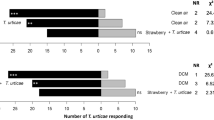Abstract
Attraction to host plants by adultRhynchophorus palmarum (L.) palm weevils was studied in the field and in the laboratory. Chemical analysis revealed the presence of ethanol and ethyl-acetate in stems of coco palms and in pineapple fruits and of pentane, hexanal, and isopentanol in coco stems. In the olfactometer, the first two compounds and isoamyl-acetate were attractive to the insects and the last three compounds, although not attractive by themselves, increased attractiveness when mixed with the first two compounds. Mixtures of these compounds, in proportions similar to the one occurring in attractive plant tissue, were as attractive as natural coconut tissue. In the field, the chemical compounds, either presented alone or as a mixture, did not attract the weevil. Males produce an aggregation pheromone when smelling ethyl-acetate. Rhynchophorol, 2(E)-6-methyl-2-hepten-4-ol, the known active component of the aggregation pheromone, attracts weevils in the olfactometer and in the field only if plant tissue, ethyl-acetate, or the above-mentioned odor mix are present. We propose that a complex mix of ethanol, ethyl-acetate, pentane, hexanal, isolamyl-acetate, and/or isopentanol serve as a short-range orientation cue to fresh wounds on the plant and that additional host odors, attracting weevils from a distance, have still to be discovered. Rhynchophorol can be considered to be a Synergist, having an anemotactic action at a distance. We recommend the use of retention traps baited with rhynchophorol, ethyl-acetate, and sugar cane as an alternative control method for the pest.
Similar content being viewed by others
References
Barreto, J.M. 1984. Diagnóstico de plagas y enfermedades del cocotero en el estado Miranda. Informe técnico FONCOPAL, 17 pp.
Bedford, G.O., Ocampo, M.M., andReyes, F. 1978. Mexico red-ring disease andRhynchophorus palmarum on coconut palms.FAO Plant Prot. Bull. 26:29.
Cerda, H.,Hernandez, J.V.,Jaffé, K.,Martinez, R., andSánchez, P. 1993. Estudio olfatométrico de la atracción del picudo del cocoteroRhynchophorus palmarum a volátiles de tejidos vegetales.Agron. Trop. In press.
Chavero, L.A. 1976. Campaña de control del “anillo rojo” del cocotero. Coco y Palma 13 & 14. Caracas.
Dean, C.G., andVelis, M. 1976. Differences in the effects of red-ring disease on coconut palms in Central America and the Caribbean and its control.Oleagineaux 31:321–326.
Flath, R.A., andForrey, R.R. 1970. Volatile components of smooth cayenne pineapple.J. Agric. Food Chem. 18:306–309.
Genty, P. 1988. Manejo y control de plagas en palma africana. VI. Seminario sobre problemas fitopatológicos de la palma africana. IICA-BID-Prociandino, Colombia, pp. 101–112.
Godshall, M.A., Roberts, E.J., andLegendre, M.G. 1980. Identification of volatile constituents responsible for characteristic molasses aroma by unconventional gas chromatography.J. Agric. Food Chem. 28:856–858.
Griffith, R. 1987. Red ring disease of coconut palm.Plant Dis. 71:193–196.
Hagley, E.A.C. 1965. Tests of attractants for the palm weevil.J. Econ. Entomol. 58:1002–1003.
Hernández, J.V., Cerda, H., Jaffé, K., andSánchez, P. 1992. Localizacion de hospedero, actividad diaria y optimizacion de las capturas mediante trampas inocuas del picudo del cocoteroRynchophorus palmarum (L).Agron. Trop. 42:211–226.
Macku, C., andJennings, W.G. 1987. Production of volatiles by ripening bananas.J. Agric. Food Chem. 35:845–848.
Morin, J.P., Lucchini, J.A.C., Ferreira, J.M.S., andFraga, L.S. 1986. Control deRhynchophorus palmarum (L.) mediante trampas construidas con pedazos de palmas.Oleagineaux 41:61–63.
Moura, J., Vilela, E., Sgrillo, R., Aguilar, M., andResende, M. 1989. A behavioral olfactory study ofRhynchophorus palmarum (L) (Coleoptera: Curculionidae) in the field.An. Soc. Entomol. Bras. 18:267–274.
Oehlschlager, A.C., Pierce, H.D., Morgan, B., Wimalaratne, P.D.C., Slessor, K.N., King, G.G.S., Gries, G., Gries, R., Borden, J.H., Jiron, L.F., Chinchilla, C.M., andMexzon, R. 1992. Chirality and field testing of rhynchophorol, the aggregation pheromone of the american palm weevilRhynchophorus palmarum (L).Naturwissenschaften 79:134–135.
Oehlschlager, A.C.,Chinchilla, C.,Gonzalez, L.M.,Jiron, L.F.,Mexzon, R., andMorgan, B. 1993. Development of a pheromone-based trapping system for the American palm weevilRhynchophorus palmarum (L).J. Econ. Entomol. Submitted.
Ponte, J.J., Lima, J.A.A., andBrandine, E. 1971. O anel vermelho do coqueiro, no estado do Ceara. 1; The red ring disease of the coconut palm in Ceara State. (Rhadinaphelenchus cocophilus). Pesqui.Agropecu. Nordeste 3:85–87.
Posada, F. 1988. Manejo de vectores insectiles del anillo rojo en palma africana, pp. 42–56,in VI Seminario sobre problemas fitopatológicos de la palma africana. IICA-BID-Prociandino, Colombia.
Rochat, D., Gonzalez, A., Marian, D., Villanueva, A., andZagatti, P. 1991a. Evidence for male produced aggregation pheromone in american palm weevil,Rhynchophorus palmarum (L).J. Chem. Ecol. 17:1221–1230.
Rochat, D., Malosse, C., Lettere, M., Ducrot, P., Zagatti, P., Renou, M., andDescoins, C. 1991b. Male-produced aggregation pheromone of the american palm weevilRhynchophorus palmarum L.: Collection, identification, elecrophysiological activity and laboratory bioassay.J. Chem. Ecol. 17:2127–2141.
Sánchez, P.,Cerda, H.,Hernández, J.V., andJaffé, K. 1993. Observaciones bio-ecológicas sobre el picudo del cocoteroRhynchophorus palmarum (L).Bol. Ven. Entomol. In press.
Siegel, S. 1956. Nonparametric Statistics. McGraw-Hill, Tokyo, 312 pp.
Vera, D.H., andOrellana, M.F. 1988. Combate de la gualpaRhynchophorus palmarum (L.) en plantaciones de cocotero y palma africana mediante la captura con trampas de insecto adulto. Inst. Nac. Inves. Agrop. Ecuador. Bol. Tec. 198, 12 pp.
Wattanapongsiri, A. 1966. A revision of the generaRhynchophorus andDynamis (Coleoptera: Curculionidae).Dept. Agric. Sci. Bull. Bangkok (Thailand) 1:328.
Author information
Authors and Affiliations
Rights and permissions
About this article
Cite this article
Jaffé, K., Sánchez, P., Cerda, H. et al. Chemical ecology of the palm weevilRhynchophorus palmarum (L.) (Coleoptera: Curculionidae): Attraction to host plants and to a male-produced aggregation pheromone. J Chem Ecol 19, 1703–1720 (1993). https://doi.org/10.1007/BF00982302
Received:
Accepted:
Issue Date:
DOI: https://doi.org/10.1007/BF00982302




